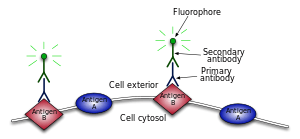Primary and secondary antibodies
Primary and secondary antibodies are two groups of antibodies that are classified based on whether they bind to antigens or proteins directly or target another (primary) antibody that, in turn, is bound to an antigen or protein.
Primary
A primary antibody can be very useful for the detection of biomarkers for diseases such as cancer, diabetes, Parkinson’s and Alzheimer’s disease and they are used for the study of ADME and multi-drug resistance (MDR) of therapeutic agents.

Secondary
Secondary antibody is especially efficient in immunolabeling. Secondary antibodies bind to primary antibodies, which are directly bound to the target antigen(s). In immunolabeling, the primary antibody's Fab domain binds to an antigen and exposes its Fc domain to secondary antibody. Then, the secondary antibody's Fab domain binds to the primary antibody's Fc domain. Since the Fc domain is constant within the same animal class, only one type of secondary antibody is required to bind to many types of primary antibodies. This reduces the cost by labeling only one type of secondary antibody, rather than labeling various types of primary antibodies. Secondary antibodies help increase sensitivity and signal amplification due to multiple secondary antibodies binding to a primary antibody[1].
Applications
Secondary antibodies can be conjugated to enzymes such as horseradish peroxidase (HRP) or alkaline phosphatase (AP); or fluorescent dyes such as fluorescein isothiocyanate (FITC), rhodamine derivatives, Alexa Fluor dyes; or other molecules to be used in various applications. Secondary antibodies are used in many biochemical assays [2] including:
- ELISA, including many HIV tests
- Western blot
- Immunostaining
- Immunohistochemistry
- Immunocytochemistry
References
- ↑ "Secondary Antibodies as Probes". www.thermofisher.com. Retrieved 2017-05-31.
- ↑ "Secondary antibody review based on formal publications". secondary-antibody.com. Retrieved 2008-04-16.